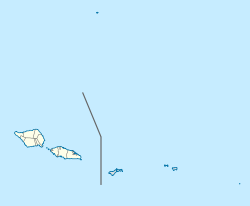Solosolo
Solosolo | |
|---|---|
Village | |
 Local surfing spot, nicknamed Plum Pudding Rock, by Solosolo. | |
 Solosolo | |
| Coordinates: 13°52′26″S 171°38′26″W / 13.87389°S 171.64056°WCoordinates: 13°52′26″S 171°38′26″W / 13.87389°S 171.64056°W | |
| Country | |
| District | Atua |
| Population (2016) | |
| • Total | 1,851 |
| Time zone | -11 |
Solosolo is a village on the northeast coast of Upolu island in Samoa. The village is in the political district of Atua and has a population of 1851.[1] It is one of the prominent settlements in the area with the largest population in its electoral constituency of Anoama'a West.
Geography[]
The villagers live on a small peninsula jutting out into the sea and bounded by Vainamo bay in the west and to the east. Settlement has grown well into the plantation hinterland in the hills above Vainamo and reaches at least 200m inland. The upland and lowland portions of the village are separated by the main east coast road connecting Solosolo to Apia, the country's capital, (30 minutes west) and eastern Upolu.
Governance[]
At the cross-roads of the village between the upland and peninsula, sits the village council maota fono. It is here that the chiefs of all the families of the village meet regularly to deliberate on the political, social, and economic affairs of the village. It is guided by the faalupega (customary greetings/genealogy) of Solosolo, which acts as a constitution for governance.
Faalupega o Solosolo Afio le paia o le Taofia o Malietoa Taulapapa ma le latou tama, Tupo-le-Sava, Afio maia le paia o le Usoalii ma e na 'au i Ao, Maliu maia le mamalu o Saleutogipo'e, o le limamatua o Faleupolu tofiga
Village[]
The main malae (village commons) of Solosolo is on the peninsula. This is where the major ceremonies and sporting events take place, and like any Samoan village is the centre of the settlement. The malae is bordered to the west by a Congregational Christian Church and to the east by a Catholic church. These were the two churches built in the village. In recent times, the village has acquired other Christian denominations including Methodist, Nazarene, Assembly of God, and Latter Day Saints. In 2016 it acquired a Seventh-Day Adventist church.[2]
The local primary school sits on the upland part of Solosolo and can be accessed by an inland sealed road.
Environment[]
Given its susceptibility to past cyclones and the mountainous terrain of the area, Solosolo's infrastructure is particularly sensitive to natural disaster. The government constructed a seawall in 2006 to ring the Vainamo bay to protect the main east coast road and the bridge over the Namo river to the west of the bay, from wave damage during cyclones. By 2019 the seawall was deteriorating due to erosion.[3]
In 2016 concerns over sea-level rise, erosion and flooding led to 60 percent of the village moving inland.[4][5][6]
Surfing[]
The bay is still renowned for surfing and is popular with visitors and local surfers, although the reef breaks are not for the inexperienced. There's a right break by a small rocky outcrop nicknamed 'Plum Pudding Rock.'
References[]
- ^ "Census 2016 Preliminary count" (PDF). Samoa Bureau of Statistics. Retrieved 2 August 2021.
- ^ Pai Mulitalo Ale (12 May 2016). "Solosolo dedicates new church". Samoa Observer. Retrieved 4 September 2021.
- ^ Ivamere Nataro (26 February 2019). "Villagers express fear". Samoa Observer. Retrieved 4 September 2021.
- ^ "Samoa's Solosolo relocates due to sea rise and mining". RNZ. 11 May 2016. Retrieved 4 September 2021.
- ^ Lagi Keresoma (10 May 2016). "Solosolo village relocating due to risks from climate change and sand mining". Talamua. Archived from the original on 4 November 2017.
- ^ Pai Mulitalo Ale (16 May 2016). "Rising sea, sand mining see Solosolo village relocate". Samoa Observer. Retrieved 4 September 2021.
External links[]
- Populated places in Atua (district)

